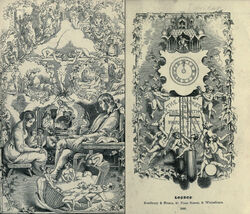
Title page of the first edition of The Cricket on the Hearth from 1845.
The Cricket on the Hearth: A Fairy Tale of Home is an 1845 novella by Charles Dickens. It is the third of Dickens' five Christmas Books, the first and best known of which is A Christmas Carol. The novella is divided into four chapters, which, in keeping with the theme of crickets from the title, are called "chirps".
Unlike A Christmas Carol and The Chimes there is relatively little social commentary in The Cricket on the Hearth. It is a sentimental story which depicts an idealized version of family life. The story was very popular during Dickens' lifetime, being performed in satge adaptations more often than A Christmas Carol, but is largely neglected today.
Plot[]
The story centers on the house which the Peerybingle family, made up of John, his wife Mary, known as Dot, and their baby, share with the baby's nanny Tilly Slowboy and a mysterious old man with a long white beard who rents a room from the Peerybingles. A chirping cricket sits constantly in front of the fireplace. The cricket acts as the house's guardian spirit, watching over and protecting those who live in it. At one point, the cricket becomes able to talk and tells John that he is wrong to suspect Dot of having an affair with the mysterious old man.
Other characters in the story are a bad-tempered and miserly toy seller called Tackleton and Caleb Plummer, a poor old toymaker who works for Tackleton. Plummer has a blind daughter called Bertha and a son named Edward, presumed to be dead after having gone to South America. Edward's former sweetheart, May, is about to marry Tackleton, a man who she does not love.
The mysterious old man at the Peerybingle's house is revealed to be Edward in disguise. Edward marries May just a few hours before she was due to marry Tackleton. Like Ebenezer Scrooge in A Christmas Carol, Tackleton mellows at the end of the story and allows May to marry the man she loves.
